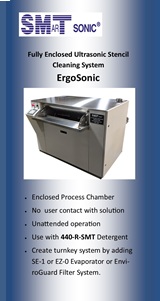|

|
|
| Ask the Experts | |||||||
|
|||||||
|
July 23, 2012 - Updated July 17, 2012 - Originally Posted SMT Component Glue StrengthIs there a recommended product or procedure to test surface mount component glue strength? S.A. |
|||||||
| Expert Panel Responses | |||||||
|
There are two basic alternatives:
Process Engineer Astronautics Fritz's career in electronics manufacturing has included diverse engineering roles including PWB fabrication, thick film print & fire, SMT and wave/selective solder process engineering, and electronics materials development and marketing. Fritz's educational background is in mechanical engineering with an emphasis on materials science. Design of Experiments (DoE) techniques have been an area of independent study. Fritz has published over a dozen papers at various industry conferences.
There IS a test procedure within the IPC-TM-650 standard,which is an invaluable document but yours absolutely FREE at http://ipc.org/4.0_Knowledge/4.1_Standards/test/2.4.42.pdf;available right now just because the IPC likes people like you! IPC-TM-650 is a compilation of many different test methods.The one I believe you are looking for, in case the link does not work, isIPC-TM-650-2.4.42 "Torsional Strength of Chip Adhesives". You can download thistest method (as well as many, many others) at this location. If by any chanceyou cannot access it, let me know directly and I will help you (Richard.stadem@gd-ais.com). Thismethod uses a 1206 size SMT capacitor and a device called a WatersManufacturing Torque Watch, and its use is also described within TM 2.4.42. Youwill need to make some type of holding fixture as well. Please note that youmay be able to lease the Torque Watch. Contact Waters for information. To further answer your question, on all chipbonderTechnical Data Sheets (and most other epoxies and adhesives) the lap sheerstrength is listed. You can compare different material properties simply byreviewing their TDSs. However, please understand that just because a givenchipbonder has a higher sheer strength than another does not necessarily meanit is better than others; with every property gain, you lose somethingelsewhere. Those with higher shear strength may also be more brittle, and havea lower stress cracking tolerance. Some may transmit (or insulate) flexurestresses from the PWB to the chip component better than others. You have tounderstand what all of the material properties mean in order to select the onebest for your particular product's field application. Note that there is no acceptance criteria; IPConly provides a standard means of testing, they cannot always tell you what is"good" or "bad". Further qualification evaluation and testing may be called forin addition to this test method.
Advanced Engineer/Scientist General Dynamics Richard D. Stadem is an advanced engineer/scientist for General Dynamics and is also a consulting engineer for other companies. He has 38 years of engineering experience having worked for Honeywell, ADC, Pemstar (now Benchmark), Analog Technologies, and General Dynamics.
There are twoadhesion strengths that are typically measured for SMT adhesives. There is theso called green strength that measures the ability of the uncured adhesive toholed a part in place. The Siemens test this involves assembling a boardplacing it on a table which is on an inclined plane the table with the board isallowed to accelerate down the plane and hit the stop. The movement of thecomponents if any is the measured. For cured adhesive the most common way is touse a torque gauge with a suitable fitting to go over the component. the gaugeis then rotated and the torque required to remove the component recorded.
Senior Applications Chemist Henkel Electronics Dr. Poole is a Senior Applications Chemist in Henkel Technologies, electronics assembly materials application engineering group. He is responsible for all of Henkel's assembly products including soldering products, underfills, PCB protection materials, and thermally conductive adhesives.
|
|||||||
| Submit A Comment | |||||||
|
Comments are reviewed prior to posting. You must include your full name to have your comments posted. We will not post your email address. |
|
Free Newsletter Subscription
Circuitnet is built for professionals who bear the responsibility of looking ahead, imagining the future, and preparing for it. Insert Your Email Address |
|

|



